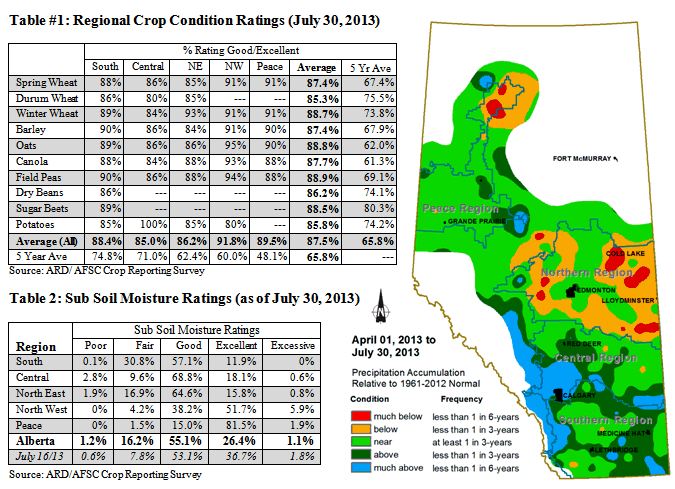| | This information has been made available by Agriculture Financial Services Corporation.
The July 30, 2013 Crop Report is also available as a PDF file on the AFSC website.
Provincial
Though weather patterns have shifted into a cooler, drier regime, frequent rain showers continue to delay haying operations and lower quality especially across the northern half of the province. Crops are progressing well with spring cereals pollinating and entering the milk stage, canola and field peas at 55 – 65% podding and winter wheat in the soft to hard dough stage.
Crop condition ratings have declined marginally but remain high at 87% rated good/ excellent. Subsoil moisture ratings have declined to 81% good/excellent from 88% two weeks ago. Hay/pasture ratings have declined to 80% good/excellent from 85% on July 16. Current ratings are 1% Poor; 19% Fair; 59% Good; 21% Excellent.
1st cut dryland haying has been prolonged by July’s showery weather. Dryland haying operations vary from virtually completed in the South region to 60% completed in the North East, North West and Peace regions. Hay quality has suffered due to the extended haying period with only 66% of the crop rated good/excellent.
Based upon current crop conditions, initial provincial yield estimates indicate yields could be 10 – 20% above long term averages for spring cereals, canola and field peas. Winter wheat yields are projected at 5% above long term averages.

Regional Assessments
Region One: Southern (Strathmore, Lethbridge, Medicine Hat, Foremost)
- Spring cereals in mid to late milk stage, winter wheat in hard dough, 80% of canola and field peas are podding.
- Crop condition ratings have been very consistent in high 80% good/excellent level.
- 1st cut dryland hay 96% complete with 78% in good/excellent quality.
- 1st cut of irrigated alfalfa hay completed. 82% good/excellent quality. 2nd cut underway.
- Sub soil moisture has declined significantly to 69% good/excellent from 86% last report.
Region Two: Central (Rimbey, Airdrie, Coronation, Oyen)
- Spring cereals in mid to late pollination stage, winter wheat in early dough, 50% of canola and 65% of field peas are podding.
- Crop condition ratings continue to improve to 85% good/excellent based upon improved growing conditions in the western portion of the region.
- 1st cut dryland hay 75% completed. 59% rated with good/excellent quality.
- Sub soil moisture ratings down marginally at 87% good/excellent. Excessive moisture in the region has declined to less than 1% from 4%.
Region Three: North East (Smoky Lake, Vermilion, Camrose, Provost)
- Spring cereals in mid pollination, winter wheat in soft dough stage, 55% of canola and 75% of field peas are podding.
- Crop condition ratings have declined slightly to 86% good/excellent.
- 1st cut dryland hay 65% completed. 75% rated with good/excellent quality.
- Sub soil moisture ratings unchanged at 80% good/excellent.
Region Four: North West (Barrhead, Edmonton, Leduc, Drayton Valley, Athabasca)
- Spring cereals in mid to late pollination stage, 40% of canola and 50% of field peas are podding.
- Crop condition ratings unchanged at 92% good/excellent from last report.
- 1st cut dryland hay is 59% complete. 42% of the crop rated with good/excellent quality.
- Sub soil moisture ratings have declined marginally to 90% good/excellent.
Region Five: Peace River (Fairview, Falher, Grande Prairie, Valleyview)
- Spring cereals in the late milk stage. 80% of canola and 90% of field peas are podding.
- Crop condition ratings have slipped to 89% good/excellent from 92% last report.
- 1st cut dryland hay is 59% completed. 81% of the crop is rated good/excellent for quality.
- Sub soil moisture rated at 96% good/excellent.
Prepared by:
James Wright
Risk Analyst, Actuarial Unit
AFSC, Lacombe
Telephone: (403)782-8336
Prepared by Agriculture Financial Services Corporation, in cooperation with Alberta Agriculture and Rural Development. For more information, please contact the writer, James Wright. |
|